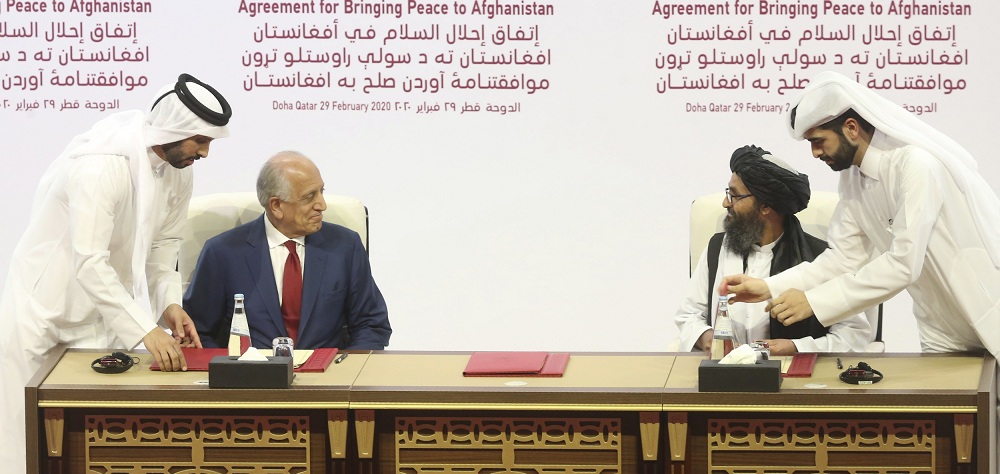Alwaght- The peace deal between the US and the Taliban which was signed on February 29 was painted by the Western media as a roadmap set to get Afghanistan out of the two-decade crisis between the central government and the insurgent groups.
Although, experts predicted obstacles ahead of its implementation, the deal was called by the American diplomats a turning point and historic peace agreement.
While the two sides still debate how to adopt the Doha agreement and withdrawal of the American troops from the Central Asian country within 14 months as it was agreed, President Donald Trump in his latest comments on the deal said that the Taliban could "possibly" overrun the United States-backed Afghan government after foreign troops withdraw from the country as part of a deal signed last week.
Responding to a question about if the Taliban could at the end of the road seize the rule from the current government after the withdrawal of the foreign forces, Trump said it is "not supposed to happen that way but it possibly will."
These comments raise some questions: Why did Trump make such comments? Does his administration intend to stab in the back of the Kabul government? To answer these questions, the comprehensive US policy in Afghanistan and the Washington Taliban strategy should be brought into the spotlight first.
Possible secret US-Taliban agreement to transfer power
What has been given publicity from the Washington-Taliban accord is definitely not all of the deal terms. Odds are that the two sides have made a secret deal, too. In fact, the two sides’ standpoints and interests are in a way that it seems quite unlikely that the US and the Taliban are satisfied with the terms of the stated deal. The fact that the Taliban militants have agreed with the US representative Zalmay Khalilzad to stop their attacks and militarism shows that the Americans have given them special privileges.
The possible scenario is an agreement based on which the Taliban have agreed to allow the US to have two military bases in the country. In return, Washington will stay out of a potential power struggle between the Taliban and the central government in Kabul. Moreover, if Washington agrees not to meddle in the Afghan home affairs, possible intra-Afghan talks will incorporate the Taliban in the Kabul power. In the next steps, the insurgent group could, even if it takes the group a sham election, seize the power and form its favorite Islamic emirate government.
After all, now the Taliban dominates a vast portion of the country. It seems that the Americans have the conviction that they have no problem with a Taliban-led government in Afghanistan. But this scenario takes an essential condition to realize: The Taliban should accept to set aside the military solution and embark on peaceful ways, mainly political ways, to engage in Afghanistan's power and political structure.
Khurasan caliphate and international rivals’ pressures
Essentially, the Taliban and the extremist Salafi groups labeled as terrorists now active in Afghanistan once were created and nurtured under American supervision and support. In the late 1970s, the US organized the Islamist forces to combat the communist government holding the power in Afghanistan. In response, with an order from Leonid Brezhnev, the Soviet Red Army was dispatched to Afghanistan and stayed there until 1989.
At the time, the US armed and equipped the Islamist groups fighting the Soviet troops in order to prevent communism in the country. But after the collapse of the Soviet rule in 1991 and the rise of the Taliban in Afghanistan in the early 2000s, the friendship between the US and the Taliban soon turned into enmity as the militant group supported Al-Qaeda, a terrorist organization that on September 11, 2001 carried out attacks in the US.
The US in 2001 invaded Afghanistan and toppled the Islamist government in Kabul. A secular government ensued, now under the American support for 19 years. But Washington policy in Afghanistan has begun to face new realities. Frequent defeats in the war against the Taliban and the US public outcry against the troops' stay and the high costs of war seem to force a shift in the White House policy in dealing with Islamist groups in Afghanistan.
To be clearer, now that the US met its failure in the scheme to split Syria and Iraq by backing ISIS (Islamic State in Iraq and Syria) and other terrorist forces to establish an Islamic state stretching across the two Arab countries, it intends to form the so-called Islamic State in Khurasan (ISK).
Since 2018, there have been reports that the US transferred the ISIS commanders and fighters from Syria and Iraq to Afghanistan amid heavy losses of the terrorist group in the two countries. The so-called Khurasan state starts from the Caucasus, mainly Muslim-majority Chechnya and Dagestan regions and reaches to Central Asia, China’s Xinjiang province, Afghanistan, Pakistan, Bangladesh, India, and parts of Iran. Through a deal or compromises, the US seeks to extricate itself of being the target of enmity of caliphatist Sunni Islamist groups and at the same time stay silent towards the rivals. The main goal is to create threats to the security environment of Russia, China, and Iran as the global challengers of the American hegemony. The Khurasan state is an issue that in case of realization can pose serious threats to Russia, China, and even India. The large number of Muslims living within the borders of the Khurasan region carries the potentials to generate a big crisis for the US competitors on a universal scale.



























